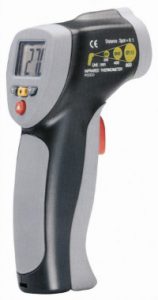Infrared Temperature Sensing Q&A
What is an IR Thermometer and why would you use one?
An Infrared Temperature Sensor is a point-and-shoot device that provides a fast and accurate reading of the surface temperature of any visible object or target. When an object or target is:
- so hot (typically above 1300°C) it will damage thermometers requiring contact to measure or damage the product itself.
- in a physically inconvenient or hazardous location, or is itself hazardous material
- one of many that you wish to rapidly measure the surface temperature of an IR thermometer is the right choice.
 Infrared temperature sensors are lightweight and require little training for competent use. They are also suitable for measuring moving targets such as conveyor systems. Since no physical contact is required, no contamination, energy loss or damage to the target can result.
Infrared temperature sensors are lightweight and require little training for competent use. They are also suitable for measuring moving targets such as conveyor systems. Since no physical contact is required, no contamination, energy loss or damage to the target can result.
How does an IR thermometer work?
Matter above absolute zero emits infrared radiation in proportion to its temperature. Infrared radiation is part of the electromagnetic spectrum. Invisible to the naked eye, IR wavelengths are between visible light and radio waves. The range used for Infrared Temperature Sensors is between 0.7 to 14 microns. Most portable handheld infrared thermometers measure in the 8 to 14 micron range.
When measuring an object’s temperature with an IR thermometer, the infrared radiation emits from the material and passes through an atmosphere to a detector. Here, it is converted into a signal and displayed measurement.
IR temperature sensors allow you to point the device at the target, pull the trigger and get very fast reading. However, it is important to consider the atmosphere or barriers between the sensor and the target being measured. Atmospheric interference such as smoke, steam or dust can result in an inaccurate measurement. Also, be alert for ambient temperature differences of 20 deg. C or greater: these will also distort results unless an adjustment period of at least twenty minutes is provided.
When the target is a reflective material, or glass is between the sensor and the target, it is inadvisable to use an infrared thermometer. Polished or shiny surfaces such as metal have a low emissivity factor, and glass is so reflective that accurate measurements are not possible.
How do you make sure your temperature measurement is correct?
Four factors are vital to accurate temperature measurement with an IR temperature sensor:
- Emissivity
- Location of a Hot Spot
- Distance to Spot Size
- Field of View
Emissivity
Energy is transmitted, reflected and emitted by objects. An Infrared Temperature Sensor will detect all three of these kinds of energy; however, for measuring temperature we are interested in emitted energy only. Some sensors will permit adjustment of the emissivity factor. You can find the typical emissivity of various materials in standardized tables.
Ideally, a target would have an emissivity factor of 1.0. This is unlikely in the real world, however: most non-metallic materials such as plastic, wood and organic materials have an emissivity around 0.8 to 0.95, while shiny metals can have an emissivity near 0.1.
Location of a Hot Spot
A hot spot is very useful in taking a temperature measurement. To find one, point the sensor away from your target area. Then scan across into your target area using an up-and-down motion to discover the hot spot.
Distance to Spot Size
This is a determination of optical resolution. The sensor is aimed at a spot; the ratio of the distance from the sensor to the target, compared to the size of the spot being measured, is the Distance to Spot Size. The larger the resulting number, the better the resolution of the sensor and the smaller the size which can be measured.
Ie. 12 to 1 optics from 12 inches away you would have spot size of 1inch and you would measure the average temperature in the 1 inch spot.
Field of View
The smaller the target area, the closer the sensor should be to take the measure. Attention needs to be given, though, to ensure the spot size is not larger than the target area. Otherwise, inaccurate readings will result because data from surrounding areas will be included in the measurement.
